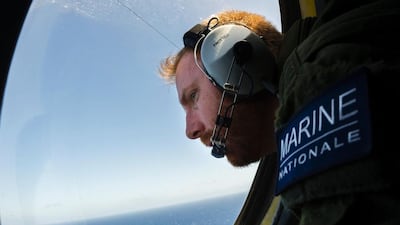CAIRO // Egyptian forensics officials collected DNA on Tuesday from relatives of EgyptAir 804 victims to help identify body parts retrieved from the Mediterranean.
Investigators are still searching the seabed for the Airbus A320’s two black boxes as they seek answers as to why the aircraft came down early on Thursday, killing all 66 people on board.
French and Egyptian aviation officials have said it is too soon to determine what caused the disaster.
France’s aviation safety agency has said the aircraft transmitted automated messages indicating smoke in the cabin and a fault in the flight control unit before contact was lost.
Finding the victims’ remains and the black boxes remain the top priorities as relatives and friends hold funeral services in Cairo to mourn their loved ones, but without the closure of being able to bury their bodies.
“Body parts arrived at the morgue yesterday and other body parts arrived the day before yesterday,” EgyptAir Holding Company chairman Safwat Musallam said on Tuesday.
“DNA samples have been collected from the victims’ families to help identify body parts.”
A submersible that can operate at 3,000 metres below sea level was deployed from Egypt’s oil ministry on Sunday in the hunt for the black boxes, according to president Abdel Fattah El Sisi.
Specialised French equipment will also be used in the search, and a French patrol boat arrived in the search area on Monday morning, where it will concentrate mainly on the surface.
According to a French navy spokesman, the priority is to find “any trace of the aircraft, for debris and victims”.
The French boat also carries hydrophones, specialised underwater microphones that may be able to locate black boxes by listening to the “pings” they emit for a month or more after being activated.
“Weather conditions have been terrible for the past few days, but that is beginning to improve,” the French spokesman added.
A source in Paris close to the search said that once more specialised gear arrives at the area, “it will take several more days” before the black boxes can be located and raised to the surface.
A French maritime surveillance plane overflying the area has already located floating objects, according to a French navy spokesman.
However, experts have warned that specialised equipment could be useless if the black boxes – which can transmit locator signals for up to five weeks – have sunk to a depth of more than 2,000 metres.
Meanwhile, experts and sources close to the investigation said local media reports that analysis of body parts showed evidence of an explosion did not in fact reveal anything about the cause of the disaster.
Hesham Abdel Hameed, head of the justice ministry’s forensics department, also denied that the reports were accurate, according to state-owned Al Ahram newspaper.
It reported Mr Abdel Hameed as saying such comments were hypothetical and could not have been issued by the department or any of its forensics doctors.
“No trace of any explosives has been found so far on debris or body parts,” one source said.
“When a plane crashes, an explosion takes place at some stage or another, reducing the plane to pieces,” another source said.
This is “either as a result of mechanical failure or a criminal act, or when the plane hits the sea after falling 11 kilometres, as in this case”.
“This does not advance the investigation, unless we find traces of an explosive, which is not the case at this stage,” the source added.
* Agence France-Presse

